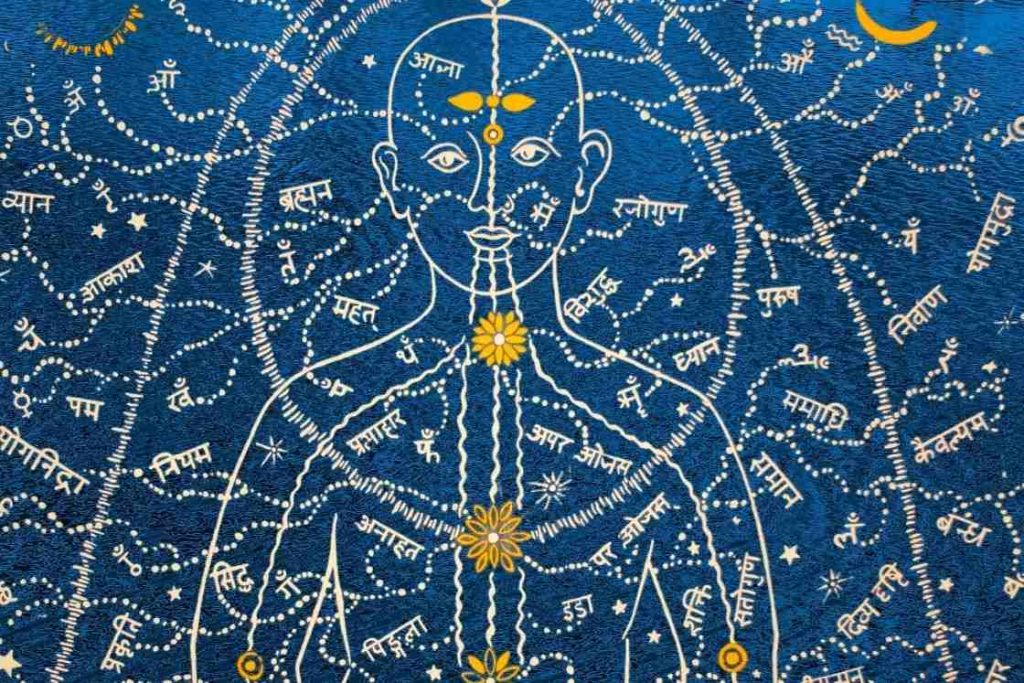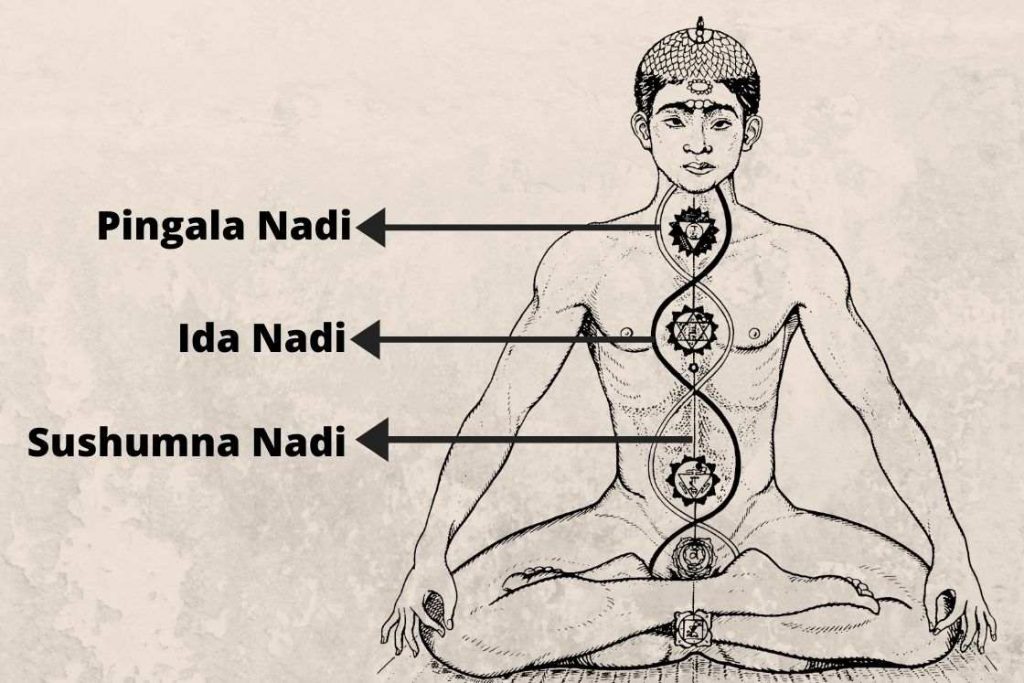
Our astral body, like our nervous system, has hundreds of channels through which energy travels — these channels are called Nadis.
Traditional health disciplines such as Ayurveda and yoga believe that all living things are nourished by their own life energy known as Prana. The Nadis are paths that allow Prana to circulate throughout the body.
The Nadis must be free of blockages and healthy. When the Nadi system is hindered, it has an impact on our physical and mental wellbeing.
This article will explain a number of important nadis; Ida, Pingala & Sushumna and what is their significance in the yogic system.
Demystifying Nadis
The term Nadi is originated from the Sanskrit root word “Nada” which means “to flow”. If we look at the literal translation, it also means “river” or “flowing river”.
In our body, Nadis are the network of energy channels that facilitate the movement of Prana in the different organs of the body. Prana is the vital force or life energy that every living being has.
The working of Nadis is the same as a tube or pipe through which water flows with ease. The nadis are said to be subtle channels that transmit energy through our existence, similar to how our visible veins carry blood via our circulatory system.
Nadis are a network of pranic, mental, and spiritual flows that run through the physical body, forming a matrix. They provide energy to every cell and organ in the body through their extensive network, which transports prana in all directions.
Similar to as ‘Prana; travels through nadis in the subtle plane, on the gross level, a nerve impulse takes place in the physical body. Nadis refer to our body’s energy channels, should not be misunderstood with nerves. Since nerves are the carrier in the physical body, in the anatomical study it can be seen but Nadis only can be perceived as energy and consciousness in motion during the deep and higher state of meditation.
Various schools of Yoga including Raja Yoga, Hatha yoga, and Kundalini Yoga aim at the awakening of Kundalini Shakti through Nadis. The flow of Kundalini shakti is possible only when are these Nadis are purified.
How many nadis are there in our body?
The network of nadis in our body is so vast and subtle that ancient texts have cited different numbers of Nadis based on their calculations.
According to Shiva Samhitha, our body consists of 350,000 Nadis.
Another text ‘Prapanchasara Tantra‘ says 300,000 Nadis are present in the human body.
Goraksha Samhita and Hatha Yoga Pradipika highlight the total number of Nadis are 72,000 and they arise from Nadi Kanda. Nadi Kanda is the ‘bird egg’ shaped root situated below to umbilicus and above the pubis.
Out of 72000 nadis, 14 nadis have been identified as important ones. They are:
- Ida – Known for its feminine and cool energy, it starts at the Muladhara and ends at the left nostril. It is also associated with the energy of the moon.
- Pingala – Known for its masculine and heating energy, it flows on the right side and ends at the right nostril. It is also associated with the energy of the sun.
- Sushumna – The main or central nadi through which the prana flows to the other nadis. It starts at Muladhara and ends at the Sahasrara chakra.
- Gandhari – It is responsible for providing energy to the left eye. It starts at the Muladhara and ends at the Ajna Chakra.
- Hastijihva – Gives energy to the left limbs, i.e., the left arm and leg. This nadi starts at Muladhara and ends at the Manipura Chakra.
- Kuhu – Provides energy to the genitals. It starts at Muladhara and ends at the Svadhisthana Chakra.
- Saraswati – Responsible for giving energy to the throat, mouth, and tongue. It starts at Muladhara and ends at the Vishuddhi chakra.
- Pusha – Gives energy to the right eye. It starts at the Muladhara and ends at the Ajna chakra.
- Shakhini – Gives energy to the left ear. It starts at the Muladhara and ends at the Ajna chakra.
- Payaswini – A complimentary nadi to the Pingala, it flows through the Saraswati and Pusha nadi and ends at the right ear.
- Varuni – Provides energy to the whole body through the nervous system. Begins at the Muladhara and ends at Anahata chakra.
- Alambusha – Provides energy to the organs responsible for the elimination of waste. It starts from the anus and ends at the mouth, moving through the Muladhara Chakra.
- Vishwodari – Gives energy to the organs related to the digestive system. It starts at Muladhara and ends at Manipura Chakra.
- Yashaswini – Provides energy to the right libs, i.e, right arm and leg. It starts at Muladhara and ends at Manipura Chakra.
3 Main Nadis – Ida, Pingala & Sushumna

From the above 14, the Ida, Pingala, and Sushumna are of utmost importance and move through the spinal cord and chakras. These 3 main Nadis are termed Trividha Nadi. Shiva Samhitha states that in between Trividha Nadi, there is a Nadi in a subtler form called Chitra Nadi.
Trividha Nadi or 3 main nadis are situated near the spine, resembling the stalk of lotus facing downwards (Adhomukha Padma).
Ida Nadi is situated towards the left side and Pingala Nadi towards the right side of Sushumna Nadi. Ida and Pingala nadis spiral around the Sushumna Nadi resembling the double helix of human DNA. They cross each other at certain points along the spine, forming Chakras.
Ida, Pingala and Sushumna Nadi meet at Triveni point which is situated at Ajna Chakra, midway between the eyebrows. Later Ida Nadi terminates at left nostrils whereas Pingala Nadi terminates at right nostrils.
1. Ida Nadi
Ida nadi symbolizes the planet moon (Chandra tattva); hence it is also called Chandra Nadi. Ida in Sanskrit means comfort hence the Ida nadi is cool in nature and nourishes the body and mind. It controls all mental processes and energizes emotions. It is responsible for the feminine, auspicious, and easy smooth activities of our personality.
The basic characteristics of the Ida nadi are introspective, self-reflection, artistic, cold, passive, receptive, restful, inward-oriented, sensitive.
The functions of Ida Nadi are anabolic in nature and can be co-related with the Parasympathetic nervous system (rest and digest system). It governs inspired or visionary speech.
People with a strong Ida energy are likely to have nurturing and intuitive qualities. However, they may lack the self-assurance, clarity, and courage necessary to achieve worldly knowledge.
Since it ends in the left nostril, it is also linked to right-brain dominance, which is considered to favor creativity and artistry.
Ida Nadi mainly operates throughout the night-time which results in a slow metabolism and a sense of relief in the night. However, sometimes the activity of Ida can also relate to tamas qualities.
Symptoms of Blocked Ida Nadi
When there is a blockage in Ida Nadi then the person will be emotionally affected, lethargic, and suffer from depression. Blocked Ida Nadi can be identified with these symptoms:
- Feeling restless in the night
- Improper digestion
- Hypothyroidism
- Increase in gas and flatulence
- High susceptibility to diabetes
- Epilepsy seizure, dementia, depression and mental health problems
- Not being able to correct bad habits
- Low assertiveness, passive behavior
Unblocking the Ida Nadi
Pranayama such as Nadi Shodhana and Surya Bheda Pranayama can be effective in clearing away blockages and imbalance of the Ida Nadi. Practicing hatha yoga can also bring about a significant change as the term “hatha yoga” literally means “sun-moon yoga,”.
2. Pingala Nadi
It symbolizes the Sun (Soorya tattva), hence it is also called as Surya Nadi. In Sanskrit, the term pingala signifies “orange” or “tawny.” In contrast to Ida, Pingala Nadi is warm, active, and stimulating in nature, hence maintaining the body temperature.
Pingala nadi is linked to left-brain dominance because it ends in the right nostril, which is thought to lead to analytical, logical and systematic thinking.
The functions of Pingala Nadi comprise body growth, catabolic activities, controlling all vital somatic processes, and can be co-related to the sympathetic nervous system (fight or flight system). It oversees more of the masculine aspects of our personality and represents the Rajas guna.
People with dominant Pingala energies are Type A personalities who are creative, assertive, and straightforward. They may, however, lack lunar qualities such as empathy, perception, and self-awareness, which are necessary for spiritual awakening.
In our body when the Pingala Nadi flows in dominance, the breath will be warm and more in the right nostril, the mind and senses are extroverted with the dominance of physical energy. Pingala Nadi influences the right side of the body, the left hemisphere, and the front part of the brain.
Symptoms of Blocked Pingala Nadi
When Pingala Nadi gets blocked it affects the person by increasing aggressive behavior, over dominating nature and may spoil the relationship with others. Also, blocked Pingala causes:
- Overeating, increased appetite, and cravings for junk food
- Acidity, ulcers
- Hyperthyroidism
- Fever
- Dryness in skin and throat
- Bronchitis and arthritis
- Improper kidney and liver functioning
- Getting frustrated easily, feeling irritated and, aggressive nature
- Increased levels of testosterone and estrogen – High sexual drive
Unblocking the Pingala Nadi
Pranayama such as Nadi Shodhana and Chandra Bhedi Pranayama can be effective in clearing away blockages and opening the Pingala Nadi. Practicing hatha yoga can also bring about a significant change as the term “hatha yoga” literally means “sun-moon yoga,”.
Comparison between Ida and Pingala Nadi
| Representations/Features | Ida Nadi | Pingala Nadi |
| Planet | Moon | Sun |
| Breath | Left nostrils | Right nostrils |
| Temperature | Cold | Hot |
| Gender | Female | Male |
| Quality | Mental | Physical |
| Nerves | Parasympathetic | Sympathetic |
| Colour | Blue | Red |
| Metal | Silver | Gold |
| River | Ganga | Yamuna |
| Energy | Negative | Positive |
How to know if Ida and Pingala are balanced?
The fundamental dual existence is represented by the Ida and Pingala. You can simply refer to it as masculine and feminine, or as your rational and intuitive sides.
The pingala energy, which is linear and logical, should balance the ida nadi energy. Bringing the Ida and Pingala into harmony can help you be more effective in the world and help combat life’s challenges.
Normally, we believe that a person generally breathes through both the nostrils simultaneously, though it is not so. Our breathing cycles alternate between ida and pingala, or left and right nostrils, every 90 minutes.
When the left nostril flows, it indicates that the mental energy (Chitta) or Ida nadi is predominant, and the Pranic energy or Pingala nadi is weak. While the right nostril flows, the Pranic forces are stronger and the mental aspect is weak.
Ida and pingala nadi can also be assessed in terms of the brain’s hemispheres. The right hemisphere, which is where mental activities take place, represents Ida. The left hemisphere represents Pingala, which is where essential processes occur.
The cleansing of the nadis brings a sense of calm. You’re confident of yourself and your perseverance, and the outcomes are usually rather pleasant. Because the thoughts are no longer bouncing between the right and left brain.
3. Sushumna Nadi
Sushumna is described as “a fountain of great joy” in the Shiva Samhita. Sushumna refers to a condition of tranquillity and balance in the flow of prana, as well as a state of harmony in the autonomic nervous system. Sushumna, in a nutshell, is the meditative state.
Sushumna Nadi is situated at the center of the spinal cord in between Ida and Pingala Nadi. It’s considered to be the most gracious, spiritual, and hidden channel like the river Saraswathi originating at the base of the spine (Muladhara Chakra).
This central channel is also known as Brahma Nadi—the pathway to Brahman or the ultimate being—because it allows yogis to achieve spiritual awakening. We leave the physical world and achieve a state of samadhi when our prana travels through the Sushumna Nadi for a long time.
The sushumna nadi runs from the base of the spine (muladhara chakra) to the crown of the head (sahasrara chakra). It is the way for kundalini energy to ascend from the base of the spine to the crown of the head. It is thought to be the main conduit for the movement of prana throughout the body. It connects all of the body’s chakras.
When Kundalini Shakti at Muladhara Chakra is awakened from the dormant state, it moves through Sushumna Nadi to reach Sahasrara Chakra. It passes through all the 6 Chakras through its path where we find 6 various Shakti like Daakini, Haakini, Kaakini, Laakini, Raakini, and Shaakini.
Moreover, the tongue in khechari mudra is used to tap the top of Sushumna Nadi to facilitate these Shakti.
In Guna’s perspective, Sushumna Nadi is called trigunamayi means it comprises all the 3 Gunas (qualities), representing the sun, moon, and fire altogether. When the Sushumna Nadi is balanced and dynamic, it is said that we achieve true harmony within ourselves and are fully attuned to the Divine.
How to activate Ida, Pingala and Sushumna

The initial purifications or shatkarma, mudras, visualization, pranayama, and mantra chanting all work together to drive prana to flow from the Ida and Pingala channels into the central Sushumna channel. The mudras especially seal up numerous openings, capturing prana and channelling it into the Sushumna.
According to the Shiva Swarodaya text, the active Nadi flows for 60 minutes. Thereafter, Sushumna functions for 1-4 minutes, and then the other Nadi begins to operate.
Sushumna can be stimulated from its dormant state via chakra meditations, allowing kundalini energy to ascend and spiritual awakening to occur. Prana energizes and activates dormant energy as it continues moving up the sushumna nadi, energizing all of the chakras along the way.
Similarly, as a technique of opening and stimulating Sushumna, Nadi shodhana pranayama can help to balance the ida and pingala nadis.
Conclusion
Different types of Nadis are dominant in various stages of life, right from birth in all humans. Yoga leads to the union of the individual soul with the universal soul. It can be achieved by harnessing the vital energy present within the body, moving through various channels.
It is necessary to look deeply into oneself into the mysteries of the mind and subtle body to reach the ultimate goal of enlightenment. By proper yoga practices under a good teacher, the person can awaken the Sushumna Nadi to maintain health and attain salvation which is the ultimate purpose of Yoga.





I have taught yoga asana and yoga beyond asana for the last four decades in America. Now at 90 years of age, my pranayama practice is no longer effective since I have been diagnosed with Pulmonary Fibrosis with breathlessness. Especially, I find it harder now practicing antara kumbhaka. My bahya kumbhaka is long and ok. It is the internat retention after inhalation causes me difficulty.
My body also has shown weight loss of about 10 lbs over a period of a year.
Would you recommend pancha karma of 21 days and if so where in Kerala or Coimbatore?
IDA naadi runs on the LEFT alongside SUSHMNA and connects to RIGHT Nostril.
…..as per Nityotsavam by Umanandanathar (extract of Kalpa Sutra by Lord Parashuram)
IDA naamni tu ya Nadi vama marge vayawasthita. Sushumnayam samaachalishya dakha nasapute gata ……
?
From Nityotsavam by Umanandanathar (extract of Kalpa Sutra by Lord Parasuram)
I practice yoga for the past 9 months. I feel a slight pressure in the forehead bone between my two eyes (3rd eye) point. Is this something good or bad?
I’ve found that chakra can and will beat as much as the heart or the sex organs. When in meditation that is the spot I focus on.
Well writtten. Madam. Plz write more on how to equalise both the nadi
Dear Madam,
How to open sushmana nadi kindly explain in details.
Please refer to this post for an explanation – Sushumna Nadi Awakening